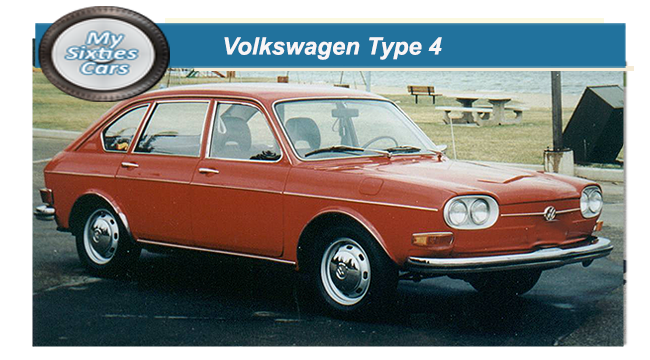
First seen at the 1961 Frankfurt Motor Show, the VW 1500, or Type 4, was only the second passenger car produced by Volkswagen.
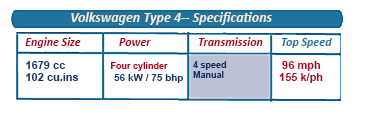 Replacing the blsndly designed Type 3 series, the Volkswagen Type 4 made it's public debut in October 1968 at the annual Paris Motor Show.
Replacing the blsndly designed Type 3 series, the Volkswagen Type 4 made it's public debut in October 1968 at the annual Paris Motor Show.
The 411, as it was tagged, was the largest passenger carrying vehicle produced by Volkswagen to date, as well as being it's most powerful, also the first Volkswagen to come with four doors.
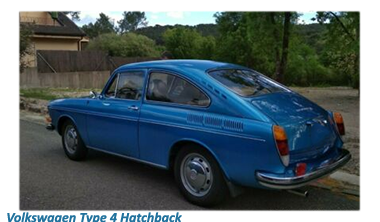 The driving force behind the transition at Volkswagen from being almost entirely dependent on sales of the “Peoples Car” to produce a full-scale family saloon for Volkswagen was the legendary Heinrich Nordhoff who had been at the helm of the country for more than twenty years.
The driving force behind the transition at Volkswagen from being almost entirely dependent on sales of the “Peoples Car” to produce a full-scale family saloon for Volkswagen was the legendary Heinrich Nordhoff who had been at the helm of the country for more than twenty years.
Sadly, Nordhoff passed away in the spring of 1968, just a few months before the Type 4 was released.
Designed by Turin based design studio Pininfarina, the Volkswagen Type 4 was available as either a two-door or four-door sedan as well as a hardy, dual-purpose two-door station wagon body style.
![]()
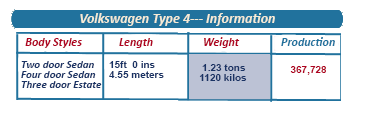 To improve passenger comfort, the 411 was the first Volkswagen to dispense with the torsion bar suspension setup traditionally used on the Beetle and all later models, with another first for the 411 was to have MacPherson struts fitted in the front, with coil springs in the rear.
To improve passenger comfort, the 411 was the first Volkswagen to dispense with the torsion bar suspension setup traditionally used on the Beetle and all later models, with another first for the 411 was to have MacPherson struts fitted in the front, with coil springs in the rear.
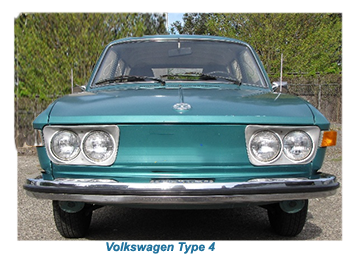 The Volkswagen Type 4, 411 was powered by an entirely new design 1679 cc engine equipped with twin carburettors, which if backed up by an optional electronic fuel injection system produced by Bosch, reportedly could push the vehicle’s power output from 68 to 80 bhp.
The Volkswagen Type 4, 411 was powered by an entirely new design 1679 cc engine equipped with twin carburettors, which if backed up by an optional electronic fuel injection system produced by Bosch, reportedly could push the vehicle’s power output from 68 to 80 bhp.
 As had been the case with the Type 3, the new Type 4 engine’s cooling fan was mounted at a small distance from the crankshaft, a situation, which apart from its technical benefits, made the deck above the rear engine much lower, making for very generous cargo-carrying abilities.
As had been the case with the Type 3, the new Type 4 engine’s cooling fan was mounted at a small distance from the crankshaft, a situation, which apart from its technical benefits, made the deck above the rear engine much lower, making for very generous cargo-carrying abilities.
The European motoring media were appreciative of Volkswagen’s apparent attempts to move gradually away from their dependence on sales of the Beetle and were quick to praise the technological developments and pleasant appearance and durability.
![]()
On the downside, and it was a major one, they and the West European public were put off by the price tag placed on the car, which was way above any of the model’s nearest rivals.
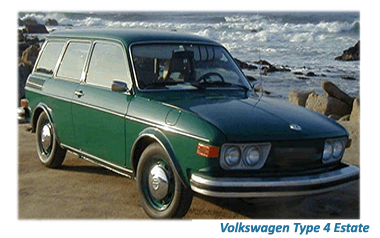 Over its six-year production run, Volkswagen produced a semi-respectable total of 367,728 Type 4s before was replaced by the first generation Passat.
Over its six-year production run, Volkswagen produced a semi-respectable total of 367,728 Type 4s before was replaced by the first generation Passat.
The Volkswagen Type 4 may not have been the tremendous commercial success that Heinrich Nordhoff had hoped for.
It did, however, send out a strong message- that Volkswagen could produce top quality full sized saloon cars for the medium price sector, a niche that they would go on to compete in very successfully in the future.





